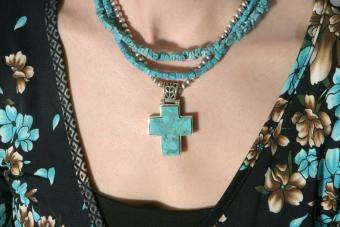
An intarsia pendant is not only a stunning piece of jewelry, but a wearable piece of art as well. It's a style that goes back centuries and requires both a keen understanding of the properties of different stones, as well as the skill to work with it to create painstaking designs.
About Intarsia Jewelry
Intarsia is an ancient method of inlaying small stones to form a pattern that is contained in a solid form such as a pendant. The finished product is polished and set flush to the base's surface. This method creates a mosaic of stones that are a one-of-a-kind work of art. Since most pieces are crafted by hand, no two are the same.
The value of an intarsia pendant is determined by how rare the stones are, as well as the precision and intricacy of the design. The intarsia technique is both time-consuming and tedious, and, as a result, there are few artists that specialize in the craft.

How Intarsia Is Made
Most intarsia pendants have a geometric look to them, which complements the stones used in creating each piece. Some have very modern lines and designs, and others are created with tiny pieces of stone to make them look like intricate mosaics.
No matter what style is created, intarsia begins with precious stones. Some of the most popular choices are:
- Opal
- Lapis
- Quartz
- Onyx
- Agate
- Mother of Pearl
- Jasper
These stones are carefully cut into thin slices and then shaped into smaller pieces from there. A sheet of stone used for intarsia pendants is only a few millimeters thick, and these delicate sheets are pieced together into whatever design the artist has chosen.
Of course, this mosaic of stone needs to be affixed to a backing of some sort. Some artists choose a larger, softer stone and carve out the center, leaving a thin "lip" on the outside edge to contain the smaller pieces of cut stone. Others use a cabochon of either gold, silver, or another metal to mount their intarsia on.
Intarsia is often secured to whatever base the artist chooses with either super glue or epoxy, though other glues might be used. Once they're secured, everything is then sanded to a smooth, even finish with multiple grades of grinders or sandpaper.
This process also serves to give each piece its polished finish. Overall, the process of creating intarsia pendants can take days to weeks, depending on how complex the design is.

How to Wear an Intarsia Pendant
Intarsia pendants can be worn for any occasion, from special events to everyday wear. You can purchase different chain lengths that will best complement the style of neckline you prefer, and intarsia pendants look good either worn closer to the throat or on a longer chain.
It's worth keeping in mind that because intarsia is often so detailed and colorful, you'll get the most impact from it if you wear an intarsia pendant against a solid colored, neutral top.
Eye-Catching Intarsia Pendants
Wearing an intarsia pendant will not only attract attention but will stir up conversation. This type of jewelry is unique and stunning. Wearing it will show your individuality and personal style while showcasing a wearable piece of art.







